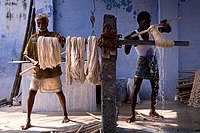Dyeing


Dyeing is the process of imparting colours to a textile material in loose fibre, yarn, cloth or garment form by treatment with a dye.
Dye types
For most of the thousands of years in which dyeing has been used by humans to decorate clothing, or fabrics for other uses, the primary source of dye has been nature, with the dyes being extracted from animals or plants. In the last 150 years, man has produced artificial dyes to achieve a broader range of colors, and to render the dyes more stable to resist washing and general use. Different classes of dye are used for different types of fiber and at different stages of the textile production process from loose fibers through yarn and cloth to completed garments.
Acrylic fibers are dyed with basic dyes, nylon and protein fibers such as wool and silk are dyed with acid dyes, polyester yarn is dyed with disperse dyes. Cotton is dyed with a range of dye types including vat dyes which are similar to the ancient natural dyes and modern synthetic reactive and direct dyes.
Methods

Dyes are applied to textile goods by dyeing from dye solutions and by printing from dye pastes.sexay
Direct application
This section needs expansion. You can help by adding to it. (June 2008) |
The term "direct dye application" stems from some dyestuff having to be either fermented as in the case of some natural dye or chemically reduced as in the case of synthetic vat and sulfur dyes before being applied. This renders the dye soluble so that it can be absorbed by the fiber since the insoluble dye has very little substantivity to the fiber. Direct dyes, a class of dyes largely for dyeing cotton, are water soluble and can be applied directly to the fiber from an aqueous solution. Most other classes of synthetic dye, other than vat and sulfur dyes, are also applied in this way.
The term may also be applied to dyeing without the use of mordants to fix the dye once it is applied. Mordants were often required to alter the hue and intensity of natural dyes and improve their color fastness. Chromium salts were until recently extensively used in dying wool with synthetic mordant dyes. These were used for economical high color fastness dark shades such as black and navy. Environmental concern has now restricted their use and they have been replaced with reactive and metal complex dyes which need no mordant.
Yarn dyeing
There are many forms of yarn dyeing. Common forms are: at package form and at hanks form. Cotton yarns are mostly dyed at package form, and acrylic or wool yarn are dyed at hank form.
The common dyeing process of cotton yarn with reactive dyes at package form is given below in short: firstly the raw yarn is wound on a spring tube to achieve package suitable for dye penetration. Then, these softened packages are loaded on a dyeing carrier's spindle one on another. The packages are next pressed up to a desired height to achieve suitable density of packing. The carrier is then loaded on the dyeing machine and the yarn is dyed. After dyeing, the packages are unloaded from the carrier into a trolly. Next, all the packages are hydro extracted to remove the maximum amount of water. All the packages are then dried to achieve the final dyed package. At last the dyed yarn packages are packed and delivered.
Removal of dyes
In order to remove natural or unwanted colour from material, the opposite process of bleaching is carried out.
If things go wrong in the dyeing process the dyer may be forced to remove the dye already applied by a process that normally known as stripping. This normally means destroying the dye with powerful reducing agents (sodium hydrosulphite) or oxidizing agents (Hydrogen peroxide or sodium hypochlorite). The process often risks damaging the substrate (fiber), where possible it is often less risky to dye the material a darker shade, black is often the easiest or last option.
History
Early evidence of dyeing comes from Pakistan where a piece of cotton dyed with a vegetable dye has been recovered from the archaeological site at Mohenjo-daro (3rd millennium BCE).[1] The dye used in this case was madder, which, along with other dyes—such as Indigo—was introduced to other regions through trade.[1] Contact with Alexander the Great, who had successfully used dyeing for military camouflage, may have further helped aid the spread of dyeing from India.[1]
See also
References
- ^ a b c Bhardwaj, H.C. & Jain, K.K., "Indian Dyes and Industry During 18th-19th Century", Indian Journal of History of Science 17 (11): 70-81, New Delhi: Indian National Science Academy.


